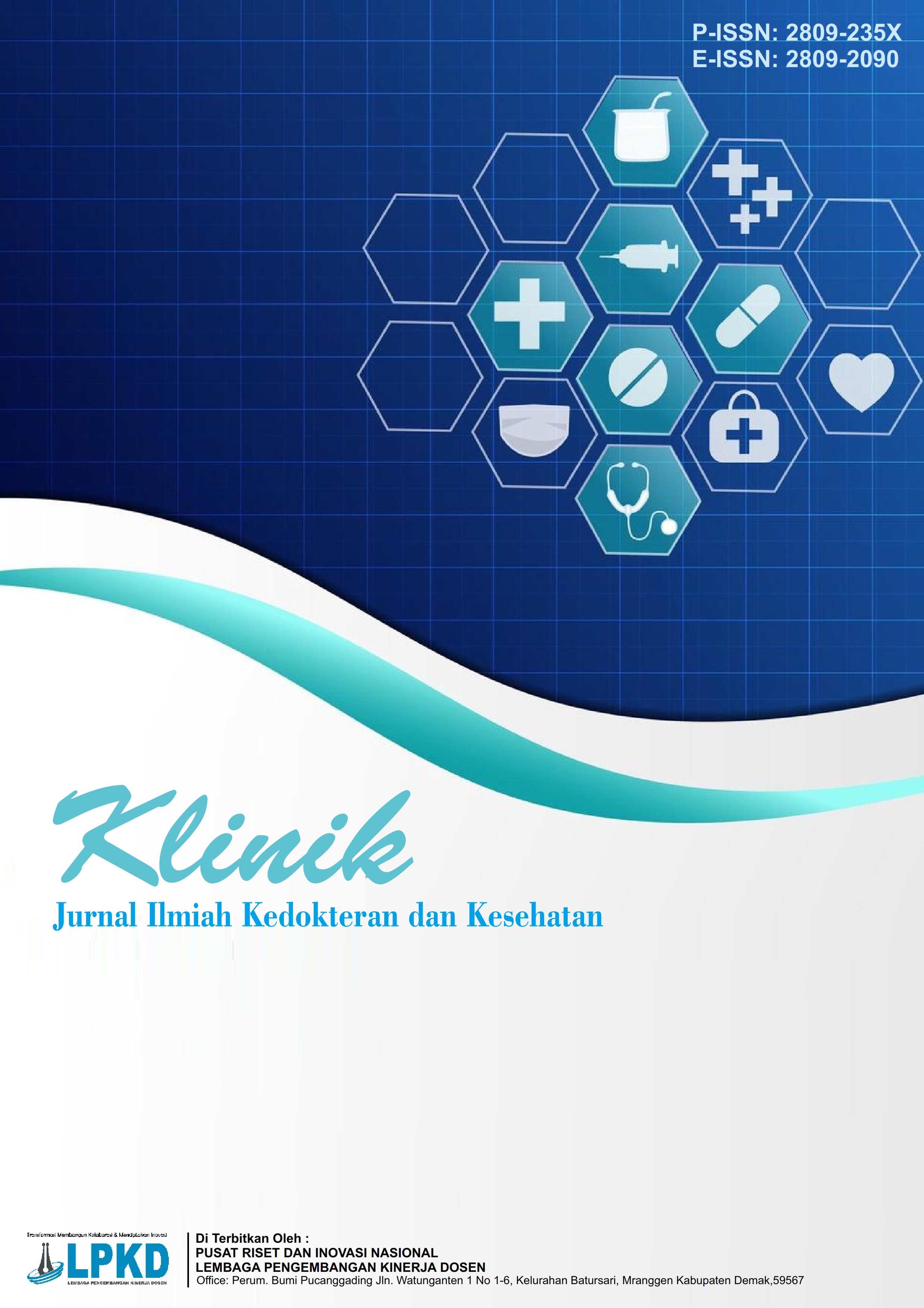Peran Malassezia spp. pada Dermatitis Seboroik: Literature Review
DOI:
https://doi.org/10.55606/klinik.v5i1.5646Keywords:
dysbiosis, hyperproliferation, Malassezia spp, pathogenesis, seborrheic dermatitisAbstract
Seborrheic dermatitis (SD) is a chronic, recurrent inflammatory skin disorder that commonly affects sebaceous-rich areas such as the scalp and central face. Although multifactorial, Malassezia spp., particularly M. globosa and M. restricta, play a central etiologic role. These lipophilic yeasts, part of the normal skin microbiota, can become opportunistic pathogens under conditions of dysbiosis, excessive sebum production, or barrier dysfunction. Metabolic products such as oleic acid disrupt epidermal integrity and induce keratinocyte hyperproliferation, while activation of pattern recognition receptors (PRRs) triggers IL-23/IL-17–mediated immune responses. This review aims to elucidate the pathogenic role of Malassezia spp. in SD and its clinical implications. Understanding this host–microbe interaction allows for targeted therapy emphasizing antifungal and anti-inflammatory strategies. By elucidating these mechanisms, new therapeutic approaches, such as antifungal agents and anti-inflammatory treatments, can be designed to better manage SD and improve patient outcomes. Understanding the role of Malassezia in SD highlights the importance of a balanced skin microbiome in maintaining skin health and preventing chronic inflammatory skin disorders.
References
Adalsteinsson, J. A., Kaushik, S., & Ferris, L. K. (2020). Advances in understanding seborrheic dermatitis: The role of Malassezia yeasts. Experimental Dermatology, 29(5), 481-489. https://doi.org/10.1111/exd.14102
Bolognia, J. L., Schaffer, J. V., & Cerroni, L. (2019). Dermatology (4th ed.). Elsevier.
Clark, G. W., & Elewski, B. E. (2022). Seborrheic dermatitis: An overview of pathogenesis and management. In Fitzpatrick's Dermatology (9th ed.). McGraw-Hill.
Dawson, T. L. (2020). Malassezia and seborrheic dermatitis: Insights into pathogenesis. Journal of Cosmetic Science, 71(5), 283-294.
Gupta, A. K., Madzia, R., & Shear, N. H. (2023). Seborrheic dermatitis: An update on etiology, pathogenesis, and treatment. Journal of the European Academy of Dermatology and Venereology, 37(6), 1104-1111. https://doi.org/10.1111/jdv.19087
Jia, Q., Zhao, J., & Xu, Y. (2024). Malassezia-induced Th17 responses and their role in chronic skin inflammation. Mycopathologia, 189(1), 85-97. https://doi.org/10.1007/s11046-023-00832-1
Li, H., Zhang, Y., & Wang, X. (2022). Morphological and molecular identification of Malassezia species in human skin diseases. Medical Mycology, 60(7), myac047. https://doi.org/10.1093/mmy/myac047
Park, H. R., Kim, J. Y., & Lee, Y. W. (2021). Pattern recognition receptors and Malassezia in seborrheic dermatitis: Current perspectives. Mycoses, 64(3), 292-299. https://doi.org/10.1111/myc.13215
Rallis, E., Katoulis, A. C., & Rigopoulos, D. (2021). Seborrheic dermatitis: An update on pathogenesis and therapeutic options. Dermatology and Therapy, 11(1), 15-27. https://doi.org/10.1007/s13555-020-00455-5
Rousel, E., de Maleissye, M. F., & Battistella, M. (2024). Skin barrier dysfunction in seborrheic dermatitis: Current understanding and future perspectives. Clinical and Experimental Dermatology, 49(2), 197-204. https://doi.org/10.1111/ced.16890
Ruchti, F., Sparber, F., & LeibundGut-Landmann, S. (2024). γδ T cells and Malassezia-specific immune responses in human skin. Frontiers in Immunology, 15, 1334-1342. https://doi.org/10.3389/fimmu.2024.12945
Sasseville, D., Bolduc, C., & Jfri, A. (2020). Seborrheic dermatitis: Clinical features and immunologic insights. In Fitzpatrick's Dermatology in General Medicine (9th ed.). McGraw-Hill.
Saunders, C. W., Scheynius, A., & Heitman, J. (2020). Malassezia fungi influence cutaneous health and disease. Nature Reviews Microbiology, 18(10), 554-565. https://doi.org/10.1038/s41579-020-0374-9
Sparber, F., Ruchti, F., & LeibundGut-Landmann, S. (2019). Host responses to Malassezia spp. in the skin: Insights into immunopathology. Seminars in Immunopathology, 41(5), 579-594. https://doi.org/10.1007/s00281-019-00758-8
Sudarmanto, S. H., Nugraha, D., & Arifin, R. (2024). Peran Malassezia spp. dalam patogenesis dermatitis seboroik. Medula, 14(11), 2133-2139. https://doi.org/10.33475/medula.v14i11.2133
Xu, J., Saunders, C. W., & Lian, W. (2021). Genomic and metabolic adaptations of Malassezia to lipid-dependent lifestyles. Fungal Genetics and Biology, 146, 103501. https://doi.org/10.1016/j.fgb.2020.103501
Yamada, T., & Kimura, T. (2023). Interplay between microbiome dysbiosis and sebaceous gland activity in seborrheic dermatitis. Frontiers in Cellular and Infection Microbiology, 13, 117-129. https://doi.org/10.3389/fcimb.2023.12194
Zhao, R., Wang, J., & Liu, Q. (2020). Lipid metabolism and its role in the pathogenesis of seborrheic dermatitis. International Journal of Molecular Sciences, 21(22), 8561. https://doi.org/10.3390/ijms21228561
Zhu, Y., Han, L., & Chen, Q. (2022). Sebum composition changes and skin microbiome interactions in seborrheic dermatitis. Scientific Reports, 12(1), 11721. https://doi.org/10.1038/s41598-022-11721-x
Downloads
Published
How to Cite
Issue
Section
License
Copyright (c) 2025 Jurnal Ilmiah Kedokteran dan Kesehatan

This work is licensed under a Creative Commons Attribution-ShareAlike 4.0 International License.








